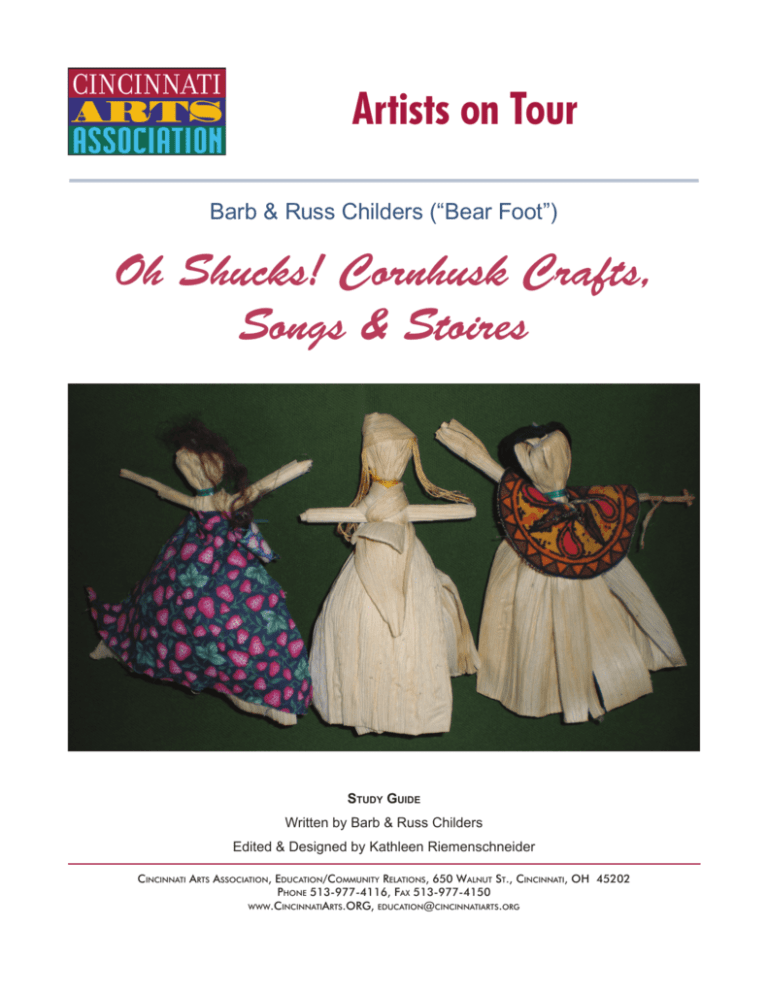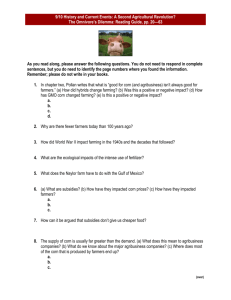
Artists on Tour
Barb & Russ Childers (“Bear Foot”)
Oh Shucks! Cornhusk Crafts,
Songs & Stoires
Study Guide
Written by Barb & Russ Childers
Edited & Designed by Kathleen Riemenschneider
Cincinnati Arts Association, Education/Community Relations, 650 Walnut St., Cincinnati, OH 45202
Phone 513-977-4116, Fax 513-977-4150
www.CincinnatiArts.ORG, education@cincinnatiarts.org
Artists’ Bios
Russ Childers has been making music since the Beatles came to town in the ‘60s. He started out
with rock ‘n roll but gravitated to old-time mountain music when he discovered his love for the music of
his Eastern Kentucky ancestors. Now he shares his knowledge of Appalachian traditions through music,
stories, and dance. Russ is active in the Ohio and Kentucky Arts Councils, as well as several Cincinnati
arts and Appalachian organizations. Barb Childers is a storyteller, dancer, musician, poet, singer,
booklover, former children’s librarian – and, since retiring, a quilter! Russ and Barb are members of the
Rabbit Hash String Band and also perform together as Bear Foot.
Background for Program
Explore southern Ohio corn from start to finish through stories, songs, and craft. Settlers coming
to Ohio on flatboats moved up the smaller rivers to find rich farmable land. Corn was easy to grow but
difficult to transport to market. Corn taken to a mill could be ground to meal, but that meant drying and
stripping the cobs. Feeding corncobs to pigs and walking the pigs to market saved time and labor. The
result? Pigs and pig products became an important industry in early Cincinnati, earning it the nickname
“Porkopolis.” Russ finds Native American, African American, Appalachian, and German influences
in the region’s music, songs, and stories, which also echo a more traditional lifestyle. Russ plays
fiddle, banjo, and lap dulcimer to teach songs related to corn that would have been familiar to early
communities in the region—“Boil The Cabbage Down” and turn the cornmeal hoecakes ‘round, or hear
about “Cotton Eyed Joe” who plays music on his cornstalk fiddle and bow. Some folks drank their corn;
the song “Hot Corn, Cold Corn” tells one way to store it. Song titles come from real-life experiences:
“Sheep Shell Corn” by trampling the corncobs into the ground and ruining the crop. Traditional stories
by the artist tell how corn got its tassel, how the greedy pig got his short nose, or the summer when all
the corn popped in the field. A hands-on craft demonstration allows children to learn firsthand about
recycling on early farms as they fashion cornhusks into dolls and dudes.
Cincinnati Arts Association Cornhusk
History of Corn
Corn, or maize, is common name for the cereal grass widely grown
for food and livestock fodder. Corn ranks with wheat and rice as one
of the world’s chief grain crops, and it is the largest crop of the United
States.
Corn is native to the Americas and was the staple grain of the
region for many centuries before Europeans reached the New World.
The origin of corn remains a mystery. Conclusive evidence exists, from
archaeological and paleobotanical discoveries, that cultivated corn
has existed in the southwestern United States for at least 3000 years.
Wild corn was once thought to have existed in the Tehuacán Valley
of southern Mexico 7000 years ago. More recent evidence puts the
appearance of corn in that region at a much later date, about 4600 years
ago. Early wild corn was not much different in fundamental botanical characteristics from the modern
corn plant.
The many varieties of corn show widely differing characteristics. Some varieties mature in two
months; others take as long as 11 months. The foliage varies in intensity of color from light to dark
green, and it may be modified by brown, red, or purple pigments. Six general groups of varieties are
differentiated by the characteristics of the kernel. Dent corn is the leading type of corn grown on U.S.
farms. The sides of the kernel consist of hard, so-called horny starch, and the crown contains soft
starch. As the grain matures, this soft starch shrinks, forming the characteristic dent. In flint corn, the
horny starch extends over the top of the kernel, so that there is no denting. Popcorn is a light, highly
popular snack throughout the United States, a variant of flint corn with small kernels of great hardness.
When heated, the moisture in the kernels expands, causing the kernels to pop open. Flour corn contains
a preponderance of soft or less densely packed starch, and it is readily ground into meal. Sweet corn
is the type commonly grown in the United States for human consumption as a vegetable. The sugar
produced by the sweet-corn plant is not converted to starch during growth, as it is in other types. The
seeds are characteristically wrinkled when the plant is allowed to mature. Pod corn is seldom used as
food but is often grown as a decorative plant; each kernel is enclosed in its own set of diminutive husks.
Another decorative corn, commonly called Indian corn, consists of multicolored varieties of flour and flint
types.
Source: Microsoft® Encarta® Encyclopedia 2001. © 1993-2000 Microsoft Corporation. All rights
reserved.
Cincinnati Arts Association Cornhusk
Instruments
Banjo – stringed instrument of the lute family, with an openbacked round body consisting of a circular wood hoop over
which is stretched a vellum belly. The only Western stringed
instrument with a vellum belly, the banjo originated in Africa
and was brought to America in the 17th century by black
slaves. Early banjos had fretless necks, a varying number
of strings, and, sometimes, gourd bodies. Adopted by white
musicians in 19th century minstrel-show troupes, the banjo
gained frets and metal strings. The five-string banjo, plucked
with the fingers, is common in folk music and commercial
bluegrass bands. The plectrum-plucked four-string banjo was popular about 1900 in vaudeville
bands.
Fiddle – any instrument from a widespread family of bowed lutes consisting of
one or more strings stretched the full length of a fingerboard terminating in a
soundbox. Fiddle is also the colloquial name given to instruments of the violin
family. Most fiddles are flat-backed. The 13th century rebec, however, is tearshaped and has a convex back like a lute. Many fiddles incorporate sympathetic
strings that vibrate when the string next to them is sounded, enriching the
overall effect. Medieval and Renaissance fiddles held at the shoulder are the
immediate predecessors of the violin. In folk fiddle traditions, from the gypsy
music of Eastern Europe to American country music, the violin was widely
adopted as the successor to the fiddle.
Dulcimer – a simple wooden Appalachian musical instrument traditionally
with 3-4 strings stretched across a long shallow tear-drop or hourglassshaped hollow sound box. Often homemade and played by self-taught
individuals, it is placed on the lap and played by sliding a noter up and
down the fretboard with one hand while strumming across all the strings
with a goose quill or pick with the other. The word “dulcimer” means
“sweet sound”: “dulcis” the Latin word for sweet and “melos” the Greek
word for sound. The mountain dulcimer – also called a “dulcymore” or
“hog fiddle” – is one of America’s oldest folk instruments. An authentic
creation unique to this nation, Kentucky recognizes it as the official folk
instrument of the Commonwealth. Handmade dulcimers were peddled
throughout the eastern Kentucky region during the late 19th century.
Even earlier than that, settlers from southern England brought to this
country an instrument they called a “dowcemerer.” Pennsylvania Germans in Virginia and West
Virginia in the early 1700s played a schietholt, a square three-stringed member of the fretted zither
family, which may also have inspired early dulcimer design.
Banjo and fiddle pictures courtesy of Uncle Mike Carr.
Dulcimer Illustration Source: Windstar Embroidery
Designs (http://www.windstarembroidery.com/Details.
cfm?ProdID=4544)
Cincinnati Arts Association Source: Microsoft® Encarta® Encyclopedia
2001. © 1993-2000 Microsoft Corporation. All
rights reserved.
Cornhusk
Activities
•
Cornhusking bee. Traditionally, the person who finds the red ear of corn buried in the pile of
unhusked corn gets to kiss the person of his or her choice!
•
Corn maze. Create one from cornstalks bundled together and laid on the ground in concentric
pattern. Travel to Germantown, Ohio, to visit Tom’s Corn Maze. (http://www.tomsmaze.com)
•
Cornhusk dolls and dudes. Gather husks from a field or buy them ready-made at a store that sells
them from tamales, e.g., Jungle Jim’s in Fairfield, Ohio, (http://www.junglejims.com/index.cfm). Find
directions for making cornhusk dolls in The Foxfire Book of Toys and Games, also in Colonial Kids:
An Activity Guide to Life in the New World by Laurie Carlson.
•
Cornhusk fiddle and bow. Contact a local farmer (or garden store) in late summer or early fall to
harvest cornstalks. Sing about Cotton-Eyed Joe who “made a cornstalk fiddle and a cornstalk bow
and if that ain’t a-fiddling then I don’t know!” Find directions for making a cornstalk fiddle and bow in
The Foxfire Book of Toys and Games and also in Homemade Instruments by Dallas Cline.
Corn recipes from different cultures. Use corn ears, meal, kernels, and husks:
»
Roast whole ears of silver queen corn in the husk Ohio-style. Purchase fresh-picked ears of local
corn. Soak the ears with the husk still on in a bucket of salted cold water for at least one hour.
Do not remove the husks, but lay the ears of corn on a grill over the prepared coals of an outdoor
charcoal grill, turning them occasionally for fifteen minutes or more until the husks dry and darken.
Remove from heat. Peel the husks back; add butter, salt, and pepper to taste. Sing “Hot corn, cold
corn, bring along a demijohn, fair thee well, Uncle Bill, see you in the morning, yes sir!”
»
Make Appalachian cornmeal cakes, sometimes called hoecakes. This name comes from when
settlers fried the batter on a hoe blade over a fire out in the cornfield. Mountain Makin’s in the
Smokies, a cookbook published by The Great Smoky Mountains Natural History Association, 1957,
gives this recipe: Mix together 2 cups of cornmeal with ½ teaspoon of salt. Scald with ½ cup boiling
water to make stiff dough. Add ½ -1 tablespoon bacon drippings and another ½ cup cold water.
Shape into oval flat “pones” and bake on a hot well greased iron griddle. Turn once. Serve them with
tasty boiled cabbage from German traditions. Sing, “Boil them cabbage down, boys, and turn the
hoecakes round, the only song I ever did sing was Boil Them Cabbage Down!” Then put the hoe
down and have an old-fashioned square dance – which was sometimes called a “hoedown”- get it?
»
Make parched corn from the Native American tradition. In More Than Moonshine: Appalachian
Recipes and Recollections by Sidney Saylor Farr (University of Pittsburgh Press, 1983), the author
says mountain hunters often carried a handful of parched corn in their pockets to ward off hunger on
long trips. To make your own, first shell the kernels from a mature ear of dried corn and fry them in
a cast iron skillet with a tablespoon of lard and a teaspoon of salt. Stir in the grains frequently until
they are deep brown in color. Enjoy them hot or cold!
»
Make Mexican tamales steamed in the cornhusks themselves.
Cincinnati Arts Association Cornhusk
Resources
Barbara McClintock: Alone in Her Field. Deborah Heiligman.
Cincinnati: An Urban History. Karen Regina.
Corn Belt Harvet. Raymond Bial.
Corn Is Maize: The Gift of the Indians. Aliki.
Four Seasons of Corn: A Winnebago Tradition. Sally M. Hunter.
The Foxfire Book of Toys and Games. Linda Garland Page.
I Like Corn. Robin Pickering.
Jamie’s Turn. Jamie DeWitt.
Legend of Food Mountain. Harriet Rohmer.
Popcorn. Alex Moran.
The Popcorn Book. Tomie DePaola.
The Story of the Milky Way: A Cherokee Tale. Joseph Bruchac.
Three Stalks of Corn. Leo Politi.
Microsoft® Encarta® Encyclopedia 2001. © 1993-2000 Microsoft Corporation. All rights reserved.
Music: A Pictorial Archive of Woodcuts & Engravings. Jim Harter.
Corn-Related Website to Explore
Explore the corn links on 42eXplore on the EduScapes web site.
http://www.42explore.com/corn.htm
Cincinnati Arts Association Cornhusk







